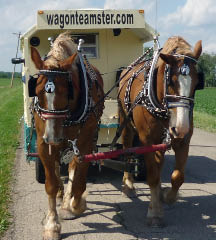|
When I started to design the wagon, I realized what I wanted was a horse-drawn recreational vehicle. I searched the web and all the books I could find, but didn’t find anything that approached the amenities offered by the modern RV. The closest I could find was the converted gypsy caravan that John and Thea Verhoeckx were using to tour Europe.
Since it’s my home, I designed it as one. It contains most of the modern conveniences that we take for granted in our homes; including, a full size bed, bathroom with shower and commode, a kitchen area with stove, refrigerator and sink and a small kitchen table. It has 12 volt and 120 volt power, hot and cold water and propane for cooking and heating. It also is made to support and care for the three horses.
Specifications
I built the wagon from scratch on a running gear, purchased from Pioneer Equipment Company. The six ton running gear includes bolster springs (for a better ride), hydraulic drum brakes on the front and mechanical brakes on the rear.
The wagon is 7 1/2 feet wide and 16 feet long. For the main carrying beams I used 2” x 10” LVLs that are 16 feet long. For this application, they are stronger then steel and much lighter. The cross beams are steel 1 1/2” x 2”, 1/8” thick tube stock. The decking is 5/8” plywood. The storage boxes were constructed of 1 1/2” perforated angle with 1/2” plywood. This resulted in a very strong base structure that only weighs about 1300 pounds.
The walls were constructed on 2 x 4 frames and sheathed with 3/8” plywood. For diagonal bracing I used metal wind bracing. All this is sided with 25 mil metal sheathing - it protects the wood and keeps the horses from cribbing on the wagon when they’re tied to it. I have a 1/12 pitch roof with rafters made from single 2 x 8’s and sheathed with 1/2” plywood. The roof is sealed with a single sheet rubber roofing.
Electric System - I have a 75 watt solar panel to help keep a charge on the battery. When I’m plugged in somewhere, I have a built in battery charger. For 120 volt AC power I have a 500 watt inverter, or I can bypass this when I’m plugged in somewhere.
Water Systems - For cold water I use a 30 gallon hot water heater for storage. An RV type pump provides the sink and shower with 45 pounds of pressure. When I’m tied in to an external faucet (via a hose reel in the wagon) I use the external source to pressurize my cold water and bypass the pump. For hot water I’m dependent on a 7 gallon, batch type, solar hot water heater. Another pump is used to supply the sink and shower (no lengthy showers).
Propane is used for the stove/oven and for heating, I have two 20 pound tanks.
To access the roof, there is an RV type aluminum ladder. Retractable stairs allow easy access in and out of the wagon. A 10 foot RV awning makes a nice porch.
The interior is insulated with 1” thick R6.5 foam insulation and covered with wood paneling, To make it appear bigger on the inside, I used white paneling. There are two cabinets in the kitchen and two mounted over the large windows. In the bathroom, there’s a medicine cabinet.
|



